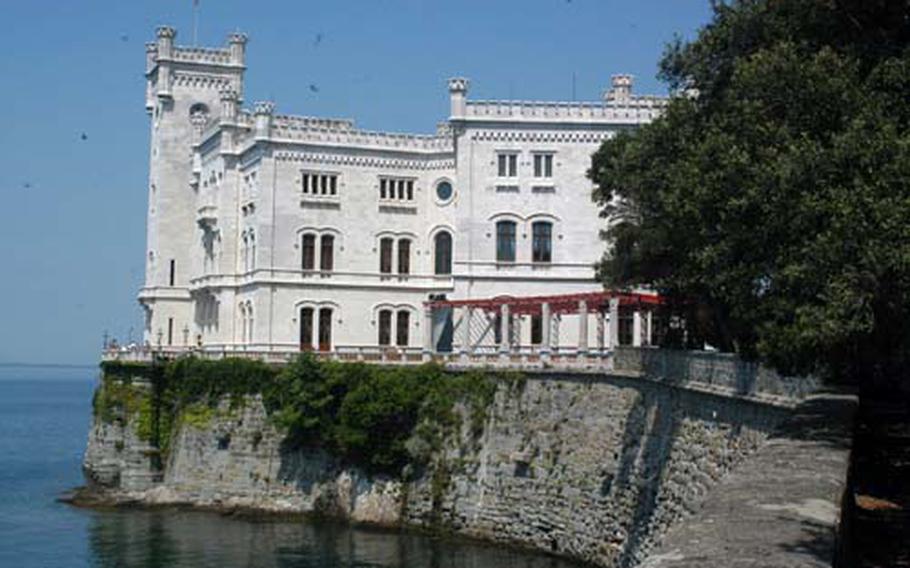
Ferdinand Maximilian, a member of the Hapsburg family that dominated central Europe for centuries, had a palace built on a spur of land projecting into the Adriatic Sea near Trieste, Italy. Miramare Castle is less than an hour's drive from Aviano Air Base. (Kent Harris / S&S)
They call it a castle. But most Americans who visit the former home of Ferdinand Maximilian — briefly emperor of Mexico — probably would say it more closely resembles a palace.
After all, it was built — from 1855 to 1860 — more as a place of luxury for one of the members of the most dominant families in Europe than as a fortress. So don’t expect to see knights in shining armor, dungeons or burning oil.
Miramare does have a history of ties with military types, though. That started with its founder, Ferdinand Maximilian, a member of the Hapsburg family. His older brother, Franz Josef, was emperor of the Austro-Hungarian empire. His nephew, Franz Ferdinand, was assassinated by a Serbian separatist — touching off World War I. But Ferdinand Maximilian had been dead for decades by then.
Maximilian served as a viceroy for the Austrian empire in Milan during a period when the empire was losing its grip on parts of Italy. Dismissed from that post, he moved east to Trieste, which was the empire’s prime port. He decided to have the castle built on a strip of land that juts out into the Adriatic Sea, a few kilometers west of Trieste. Maximilian loved the sea and was a commander of the empire’s navy. Several of the rooms in the castle are constructed to resemble the interiors of ships from that era.
Maximilian spent only about four years in Miramare, though, before accepting an offer to become emperor of Mexico. His reign lasted only a few years and he was shot to death by a firing squad in 1867.
Miramare had a number of owners after that. Notable among them was Amedeo, the duke of Aosta. His family lived in the palace in the 1930s. He was a commander in the Italian air force and later viceroy of Ethiopia. Like Maximilian, he died far from home after becoming a prisoner of war in World War II.
German forces occupied Miramare during the war. After the area was liberated, the U.S. Army made the palace its headquarters for its peacekeeping efforts in Trieste, whose status was disputed following the war. A plaque outside the palace is about all that’s left to mark the seven years that Americans were based there.
Since then, Miramare has been open to the public. Several rooms were refurbished to resemble how they might have appeared during the days of Maximilian or Amedeo. The palace sits in a large park area where visitors can take shaded walks around numerous varieties of trees and plants or visit exhibits of tropical birds and a small aquarium. The park is essentially bordered by the SS14 motorway and the Adriatric. And there are plenty of spots surrounding it where tourists sunbathe. Sometimes partially clothed.
So a day trip to Miramare could easily include some history, some nature walking and some time getting a tan — possibly what Maximilian envisioned for himself when he had the place built all those years ago.
On the QTDirectionsMiramare is less than an hour’s drive from Aviano, a few kilometers west of Trieste in northeastern Italy. From Aviano, take the A28 to the A4 and head toward Trieste. Take an immediate exit after the toll booth (watching carefully for traffic) and head toward Trieste on the SS-14. Miramare is about 15 kilometers from the A4. Parking can be an issue at this time of year. The best bet might be to find a spot along the SS-14 and walk the equivalent of a few blocks past the sunbathers to the park entrance.
TimesThe castle is open 9 a.m. to 7 p.m. daily. The park is open 8 a.m. to 7 p.m. daily from April to September and closes an hour or two earlier the rest of the year. Parco Tropicale, which features tropical birds and butterflies, is open 10 a.m. to 6 p.m. March through October and closes two hours earlier the rest of the year. The visitors center is open 9 a.m. to 12:30 p.m. and 2:30-6:30 p.m. April through September. It closes at 5 p.m. the rest of the year and is also closed Mondays and Thursdays.
CostsAdmission to the park is free. It costs 4 euros for adults to enter the castle (with cheaper prices for older and younger European Union citizens). Parco Tropicale charges 6.50 euros for adults, 5 euros for students and 3.50 euros for children. Those taking the A4 from Portogruaro to the toll booth will pay 4 euros each way. The parking lot, which is often full this time of year, charges 1 euro for one hour, 3.40 for three hours and 3 euros for each hour after that.
FoodCaffe Massimiliano in the park serves sandwiches (4 euros), pizza by the slice (3.60 euros), bottled water (70 euro cents), sodas and snacks. There are a few restaurants right outside the park and scores mixed among the hotels along the SS-14.
InformationThere’s information online in English at www.castello-miramare.it. Phone: 0402-24143. E-mail: info@castello-miramare.it. There’s a tourist office at the entrance to the park, but it’s geared for the Friuli-Venezia Giulia region and not the castle. There’s an information window inside the castle and more information at the visitors center to the northwest of the castle. Taking photographs is not allowed inside the castle.